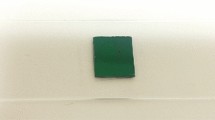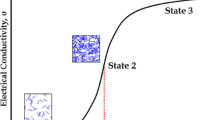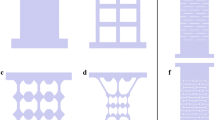Abstract
The sensitivity of randomly distributed multi-walled carbon nanotube (MWCNT)/polymer nanocomposite sensors has been extensively investigated, while that of aligned nanocomposite sensors is to be explored. In this paper, a novel hybrid computational scheme is presented for the transversely isotropic sensing behaviors of aligned MWCNT/polymer nanocomposite sensors combining micromechanics and finite element simulations. Specifically, the strain-dependent tunneling effect and multi-scale simulation of underlying heterogeneous microstructures are analyzed cooperatively to quantitatively illustrate the electromechanical coupling phenomenon of strain sensors. First, the effective elastic and electric properties of coated MWCNT with the weak interface connection are calculated by the Mori–Tanaka method on the microscopic scale. Then, the mesoscopic representative volume element (RVE) is established by coated MWCNTs as inclusions and polymer as the matrix. The tunneling effect and electric damage process are implemented with a proposed strain-dependent tunneling distance. Next, the macroscopic strain sensing behaviors of homogenized RVEs are evaluated with finite element simulations. The predicted resistance change ratio and sensitivity of aligned MWCNT/polymer nanocomposite sensors are both consistent with the experimental data over a wide loading range. This research has demonstrated the high sensing performance of aligned MWCNT/polymer nanocomposite sensors along the preferred direction.


Copyright 2011 Elsevier

















Similar content being viewed by others
References
Slobodian, P., Danova, R., Olejnik, R., Matyas, J., Münster, L.: Multifunctional flexible and stretchable polyurethane/carbon nanotube strain sensor for human breath monitoring. Polym. Adv. Technol. 30, 1891–1898 (2019)
Geng, Y., Cao, R., Innocent, M.T., Hu, Z., Zhu, L., Wang, L., Xiang, H., Zhu, M.: A high-sensitive wearable sensor based on conductive polymer composites for body temperature monitoring. Compos. Part A Appl. 163, 107269 (2022)
Akhtar, I., Chang, S.H.: Highly aligned carbon nanotubes and their sensor applications. Nanoscale 12, 21447–21458 (2020)
Huang, H., Su, S., Wu, N., Wan, H., Wan, S., Bi, H., Sun, L.: Graphene-based sensors for human health monitoring. Front. Chem. 399, 66 (2019)
Sánchez-Romate, X.F., Artigas, J., Jiménez-Suárez, A., Sánchez, M., Güemes, A., Ureña, A.: Critical parameters of carbon nanotube reinforced composites for structural health monitoring applications: empirical results versus theoretical predictions. Compos. Sci. Technol. 171, 44–53 (2019)
Sun, X., Sun, J., Li, T., Zheng, S., Wang, C., Tan, W., Zhang, J., Liu, C., Ma, T., Qi, Z.: Flexible tactile electronic skin sensor with 3D force detection based on porous CNTs/PDMS nanocomposites. Nano-Micro Lett. 11, 1–14 (2019)
Nankali, M., Nouri, N.M., Malek, N.G., Amjadi, M.: Dynamic thermoelectromechanical characterization of carbon nanotube nanocomposite strain sensors. Sens. Actuator A Phys. 332, 113122 (2021)
Liu, M.Y., Hang, C.Z., Wu, X.Y., Zhu, L.Y., Wen, X.H., Wang, Y., Zhao, X.F., Lu, H.L.: Investigation of stretchable strain sensor based on CNT/AgNW applied in smart wearable devices. Nanotechnology 33, 255501 (2022)
Cetin, M.S., Toprakci, H.A.K.: Flexible electronics from hybrid nanocomposites and their application as piezoresistive strain sensors. Compos. Part B Eng. 224, 109199 (2021)
Nadgir, O., Dornisch, W., Müller, R., Keip, M.A.: A phase-field model for transversely isotropic ferroelectrics. Arch. Appl. Mech. 89, 1057–1068 (2019)
Wang, S., Yi, M., Xu, B.X.: A phase-field model of relaxor ferroelectrics based on random field theory. Int. J. Solids Struct. 83, 142–153 (2016)
Chen, Y.H., Lu, T.J.: Cracks and fracture in piezoelectrics. Adv. Appl. Mech. 39, 121–215 (2003)
Yan, T., Wang, Z., Pan, Z.J.: Flexible strain sensors fabricated using carbon-based nanomaterials: a review. Curr. Opin. Solid State Mater. Sci. 22, 213–228 (2018)
Yan, T., Wu, Y., Yi, W., Pan, Z.: Recent progress on fabrication of carbon nanotube-based flexible conductive networks for resistive-type strain sensors. Sens. Actuator A Phys. 327, 112755 (2021)
Sirohi, J., Chopra, I.: Fundamental understanding of piezoelectric strain sensors. J. Intell. Mater. Syst. Struct. 11, 246–257 (2000)
Huo, Z., Wang, X., Zhang, Y., Wan, B., Wu, W., Xi, J., Yang, Z., Hu, G., Li, X., Pan, C.: High-performance Sb-doped p-ZnO NW films for self-powered piezoelectric strain sensors. Nano Energy 73, 104744 (2020)
Lynch, C.S.: The effect of uniaxial stress on the electro-mechanical response of 8/65/35 PLZT. Acta Mater. 44, 4137–4148 (1996)
Xia, X., Zhong, Z.: Conservation integrals for the interfacial crack in bimaterial and layered ferroelectrics. Eng. Fract. Mech. 134, 202–217 (2015)
Huber, J.E., Fleck, N.A., Landis, C.M., McMeeking, R.M.: A constitutive model for ferroelectric polycrystals. J. Mech. Phys. Solids 47, 1663–1697 (1999)
Miehe, C., Welschinger, F., Hofacker, M.: A phase field model of electromechanical fracture. J. Mech. Phys. Solids 58, 1716–1740 (2010)
Xu, B.X., Schrade, D., Gross, D., Mueller, R.: Phase field simulation of domain structures in cracked ferroelectrics. Int. J. Fract. 165, 163–173 (2010)
Kiefer, B., Lagoudas, D.C.: Modeling the coupled strain and magnetization response of magnetic shape memory alloys under magnetomechanical loading. J. Intell. Mater. Syst. Struct. 20, 143–170 (2009)
Keip, M.A., Steinmann, P., Schröder, J.: Two-scale computational homogenization of electro-elasticity at finite strains. Comput. Methods Appl. Mech. Eng. 278, 62–79 (2014)
Schröder, J., Keip, M.A.: Two-scale homogenization of electromechanically coupled boundary value problems. Comput. Mech. 50, 229–244 (2012)
Wang, Y., Weng, G.J.: Magnetoelectric coupling and overall properties of multiferroic composites with 0–0 and 1–1 connectivity. J. Appl. Phys. 118, 174102 (2015)
Humer, A., Pechstein, A.S., Meindlhumer, M., Krommer, M.: Nonlinear electromechanical coupling in ferroelectric materials: large deformation and hysteresis. Acta Mech. 231, 2521–2544 (2020)
Nag, A., Alahi, M., Eshrat, E., Mukhopadhyay, S.C., Liu, Z.: Multi-walled carbon nanotubes-based sensors for strain sensing applications. Sensors 21, 1261 (2021)
Allaoui, A., Hoa, S.V., Pugh, M.D.: The electronic transport properties and microstructure of carbon nanofiber/epoxy composites. Compos. Sci. Technol. 68, 410–416 (2008)
Wang, Y., Weng, G.J., Meguid, S.A., Hamouda, A.M.: A continuum model with a percolation threshold and tunneling-assisted interfacial conductivity for carbon nanotube-based nanocomposites. J. Appl. Phys. 115, 193706 (2014)
Simmons, J.G.: Electric tunnel effect between dissimilar electrodes separated by a thin insulating film. J. Appl. Phys. 34, 2581–2590 (1963)
Lu, X., Yvonnet, J., Detrez, F., Bai, J.: Multiscale modeling of nonlinear electric conductivity in graphene-reinforced nanocomposites taking into account tunnelling effect. J. Comput. Phys. 337, 116–131 (2017)
Hu, N., Karube, Y., Yan, C., Masuda, Z., Fukunaga, H.: Tunneling effect in a polymer/carbon nanotube nanocomposite strain sensor. Acta Mater. 56, 2929–2936 (2008)
Hu, N., Karube, Y., Arai, M., Watanabe, T., Yan, C., Li, Y., Liu, Y., Fukunaga, H.: Investigation on sensitivity of a polymer/carbon nanotube composite strain sensor. Carbon 48, 680–687 (2010)
Duan, L., Fu, S., Deng, H., Zhang, Q., Wang, K., Chen, F., Fu, Q.: The resistivity-strain behavior of conductive polymer composites: stability and sensitivity. J. Mater. Chem. A 2, 17085–17098 (2014)
Natarajan, T.S., Eshwaran, S.B., Stöckelhuber, K.W., Wießner, S., Pötschke, P., Heinrich, G., Das, A.: Strong strain sensing performance of natural rubber nanocomposites. ACS Appl. Mater. Interfaces 9, 4860–4872 (2017)
Cortés, A., Sánchez-Romate, X.F., Jiménez-Suárez, A., Campo, M., Ureña, A., Prolongo, S.G.: Mechanical and strain-sensing capabilities of carbon nanotube reinforced composites by digital light processing 3D printing technology. Polymers 12, 975 (2020)
Abshirini, M., Charara, M., Liu, Y., Saha, M., Altan, M.C.: 3D printing of highly stretchable strain sensors based on carbon nanotube nanocomposites. Adv. Eng. Mater. 20, 1800425 (2018)
Wang, Z., Ye, X.: A numerical investigation on piezoresistive behaviour of carbon nanotube/polymer composites: mechanism and optimizing principle. Nanotechnology 24, 265704 (2013)
Xia, X.D., Zhao, S.J., Fang, C., Weng, G.J.: Modeling the strain-dependent electrical resistance and strain sensitivity factor of CNT-polymer nanocomposites. Math. Method. Appl. Sci. 66, 1–15 (2020)
Xia, X.D., Zhao, S.J., Yin, H.M., Weng, G.J.: Revealing the AC electromechanically coupled effects and stable sensitivity on the dielectric loss in CNT-based nanocomposite sensors. Mater. Des. 216, 110557 (2022)
Tang, Z.H., Li, Y.Q., Huang, P., Wang, H., Hu, N., Fu, S.Y.: Comprehensive evaluation of the piezoresistive behavior of carbon nanotube-based composite strain sensors. Compos. Sci. Technol. 208, 108761 (2021)
Xia, X.D., Zhao, S.J., Zhang, J.J., Fang, C., Weng, G.J.: A unified investigation into the tensile and compressive sensing performance in highly sensitive MWCNT/epoxy nanocomposite strain sensor through loading-dependent tunneling distance. Compos. Sci. Technol. 230, 109723 (2022)
Matos, M.A.S., Tagarielli, V.L., Baiz-Villafranca, P.M., Pinho, S.T.: Predictions of the electro-mechanical response of conductive CNT-polymer composites. J. Mech. Phys. Solids 114, 84–96 (2018)
Matos, M.A.S., Tagarielli, V.L., Pinho, S.T.: On the electrical conductivity of composites with a polymeric matrix and a non-uniform concentration of carbon nanotubes. Compos. Sci. Technol. 188, 108003 (2020)
Yang, H., Yuan, L., Yao, X.F., Fang, D.N.: Piezoresistive response of graphene rubber composites considering the tunneling effect. J. Mech. Phys. Solids 139, 103943 (2020)
Santos, A.R., Amorim, L., Nunes, J.P., Silva, A.F., Viana, J.C.: Aligned carbon nanotube-based sensors for strain monitoring of composites. IEEE Sens. J. 21, 14718–14725 (2021)
Oliva-Avilés, A.I., Avilés, F., Sosa, V.: Electrical and piezoresistive properties of multi-walled carbon nanotube/polymer composite films aligned by an electric field. Carbon 49, 2989–2997 (2011)
Santos, A., Amorim, L., Nunes, J., Rocha, L., Silva, A., Viana, J.: Aligned carbon nanotube based sensors for strain sensing applications. Sens. Actuator A Phys. 289, 157–164 (2019)
Parmar, K., Mahmoodi, M., Park, C., Park, S.S.: Effect of CNT alignment on the strain sensing capability of carbon nanotube composites. Smart Mater. Struct. 22, 075006 (2013)
Oliva-Avilés, A., Avilés, F., Seidel, G.T., Sosa, V.: On the contribution of carbon nanotube deformation to piezoresistivity of carbon nanotube/polymer composites. Compos. Part B Eng. 47, 200–206 (2013)
Talamadupula, K.K., Seidel, G.D.: Statistical analysis of effective electro-mechanical properties and percolation behavior of aligned carbon nanotube/polymer nanocomposites via computational micromechanics. Comput. Mater. Sci. 197, 110616 (2021)
Andrews, R., Weisenberger, M.: Carbon nanotube polymer composites. Curr. Opin. Solid Struct. Mater. 8, 31–37 (2004)
Hill, R.: Theory of mechanical properties of fiber-strengthened materials: I. Elastic behavior. J. Mech. Phys. Solids 13, 89–101 (1964)
Weng, G.J.: Some elastic properties of reinforced solids, with special reference to isotropic ones containing spherical inclusions. Int. J. Eng. Sci. 22, 845–856 (1984)
Xia, X., Wang, Y., Zhong, Z., Weng, G.J.: A theory of electrical conductivity, dielectric constant, and electromagnetic interference shielding for lightweight graphene composite foams. J. Appl. Phys. 120, 085102 (2016)
Xia, X.D., Hao, J., Wang, Y., Zhong, Z., Weng, G.J.: Theory of electrical conductivity and dielectric permittivity of highly aligned graphene-based nanocomposites. J. Phys. Condens. Matter 29, 205702 (2017)
Qiu, Y., Weng, G.: On the application of Mori-Tanaka’s theory involving transversely isotropic spheroidal inclusions. Int. J. Eng. Sci. 28, 1121–1137 (1990)
Landau, L.D.: On the theory of phase transitions. I. Zh. Eksp. Teor. Fiz. 11, 19 (1937)
Sarfraz, M., Ba-Shammakh, M.: Synergistic effect of incorporating ZIF-302 and graphene oxide to polysulfone to develop highly selective mixed-matrix membranes for carbon dioxide separation from wet post-combustion flue gases. J. Ind. Eng. Chem. 36, 154–162 (2016)
Kim, S., Mulholland, G., Zachariah, M.: Density measurement of size selected multiwalled carbon nanotubes by mobility-mass characterization. Carbon 47, 1297–1302 (2009)
van de Leemput, L., van Kempen, H.: Scanning tunnelling microscopy. Rep. Prog. Phys. 55, 1165–1240 (1992)
Xia, X.D., Guo, X., Weng, G.J.: Creep rupture in carbon nanotube-based viscoplastic nanocomposites. Int. J. Plast. 150, 103189 (2022)
Acknowledgements
Funded by the Alexander von Humboldt Research Fellowship (Grant No. CHN 1210283 HFST-P) and the National Natural Science Foundation of China (Grant No. 12372158).
Author information
Authors and Affiliations
Corresponding author
Ethics declarations
Conflict of interest
On behalf of all authors, the corresponding author states that there is no conflict of interest.
Additional information
Publisher's Note
Springer Nature remains neutral with regard to jurisdictional claims in published maps and institutional affiliations.
Appendices
Appendix A: The explicit expressions of \({\mathbf{S}}_{{\text{int}}}^{(\sigma )}\) and \({\mathbf{S}}_{{\text{int}}}^{(\chi )}\) in Eqs. (10) and (11)
The explicit expressions of \({\mathbf{S}}_{{\text{int}}}^{(\sigma )}\) are given as [57]
Here, \(g(\alpha_{{{\text{CNT}}}} ) = \left[ {\alpha_{{{\text{CNT}}}} /(\alpha_{{{\text{CNT}}}}^{2} - 1)^{3/2} } \right] \cdot \left[ {\alpha\,_{{{\text{CNT}}}} (\alpha_{{{\text{CNT}}}}^{2} - 1)^{1/2} - {\text{arccosh}}\,\alpha_{{{\text{CNT}}}} } \right]\) for MWCNT with \(\alpha_{{{\text{CNT}}}} > 1\),
In addition, the explicit expressions of \({\mathbf{S}}_{{\text{int}}}^{(\chi )} = {\text{diag}}\{ S_{11}^{(\chi )} ,S_{22}^{(\chi )} ,S_{33}^{(\chi )} \}\) are given as [58]
Appendix B: Some material and geometric parameters of RVEs listed in the tables
Rights and permissions
Springer Nature or its licensor (e.g. a society or other partner) holds exclusive rights to this article under a publishing agreement with the author(s) or other rightsholder(s); author self-archiving of the accepted manuscript version of this article is solely governed by the terms of such publishing agreement and applicable law.
About this article
Cite this article
Xia, X., Niekamp, R., Brands, D. et al. A hybrid computational scheme on electromechanically coupled behaviors of aligned MWCNT/polymer nanocomposite sensors with strain-dependent tunneling effect. Arch Appl Mech 93, 4305–4325 (2023). https://doi.org/10.1007/s00419-023-02493-2
Received:
Accepted:
Published:
Issue Date:
DOI: https://doi.org/10.1007/s00419-023-02493-2




